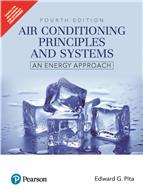Air Conditioning Principles and Systems: An Energy Approach, 4/e

|
Author(s):
Author:
Edward G. Pita
- ISBN:9789352866724
- 10 Digit ISBN:935286672X
-
Price:Rs. 990.00
- Pages:584
- Imprint:Pearson Education
- Binding:Paperback
- Status:Available
-
|
This text explores the fundamental concepts of air conditioning and their application to systems—explaining all concepts in a clear, practical manner, and focusing on problems and examples typically encountered on the job. It covers the latest, yet practical methods of load calculations, psychometrics, system design, and equipment description and performance.
Table of Content
An Air Conditioning Fable.
1. The Scope and Uses of Air Conditioning.
2. Physical Principles.
3. Heating Loads.
4. Furnaces and Boilers.
5. Hydronic Piping Systems and Terminal Units.
6. Cooling Load Calculations.
7. Psychrometrics.
8. Fluid Flow in Piping and Ducts.
9. Piping, Valves, Ducts, and Insulation.
10. Fans and Air Distribution Devices.
11. Centrifugal Pumps, Expansion Tanks, and Venting.
12. Air Conditioning Systems and Equipment.
13. Refrigeration Systems and Equipment.
14. Automatic Controls.
15. Energy Utilization and Conservation.
16. Instrumentation, Testing, and Balancing.
17. Planning and Designing the HVAC System.
18. Solar Heating and Cooling Systems. "
|
Salient Features
1. Describes energy codes and standards, and examines each topic from an energy conservation viewpoint which is essential for all future work in the air conditioning field.
2. Covers indoor air quality; air pollution from combustion; and the environmental requirements on refrigerants.
3. Exahustive Coverage of HVAC equipment description, performance, selection and specifications.
4. Include example projects which provide students with hands-on learning experiences that require them to analyze how the system functions and is essential for installation, operation, and service as well as design. "
|
|
|
|
|